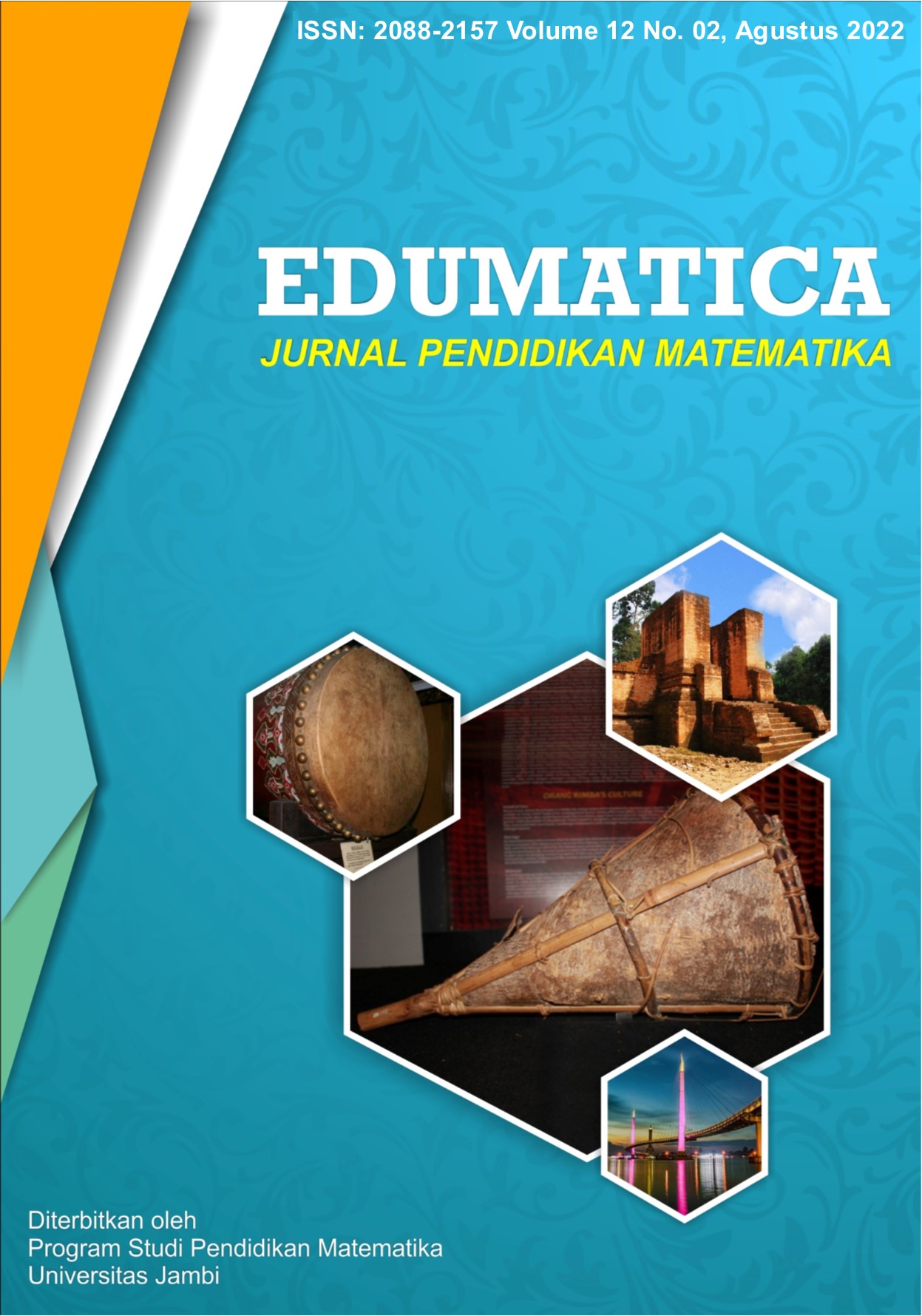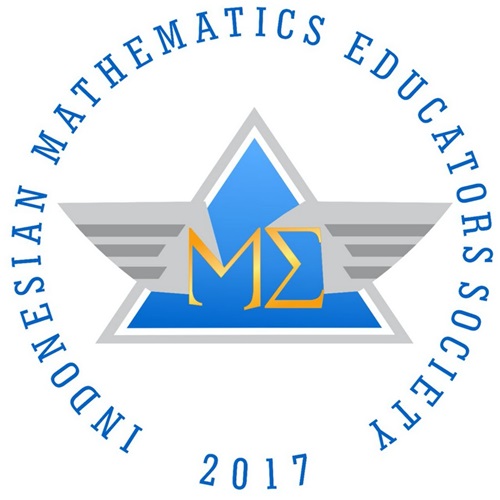Analysis of Students' Mathematical Thinking Processes in Solving Mathematical Problems
DOI:
https://doi.org/10.22437/edumatica.v12i02.15647Keywords:
problem solving, problem solving strategy, thinking processAbstract
Mathematics learning activities in schools tend to emphasize students to be able to solve problems with existing formulas. Likewise, teachers who pay less attention to and practice various problem-solving strategies. Thus, students are less able to express their thinking processes. This study aims to determine the students' mathematical thinking processes in solving mathematical problem-solving problems given. This type of research is descriptive qualitative with research subjects consisting of 6 students of class X Social Sciences SMA Islam Plus Adzkia Medan selected by purposive sampling method. The data collection technique was carried out using research instruments in the form of a description test which amounted to 3 questions and interviews. The results showed that the thinking processes used by students in solving problems were different. There are several problem-solving strategies used by students as a form of their thinking process. In the first question, there are three strategies used by students, namely act it out (conducting experiments), logical thinking, and different points of view. In the second question, all students used the strategy of registering all the possible answers that were explained directly or using the strategy of making tables. For the third question, there are two thinking strategies, namely by using formulas and strategies to find patterns. However, it was also found that there were still students who had inappropriate thinking processes.
Downloads
References
Apriliana, R., Subekti, E. E., & Wardana, M. Y. S. (2021). Analisis Kesulitan Belajar Siswa pada Pembelajaran Matematika Materi Pecahan dilihat dari Kemampuan Menyelesaikan Pemecahan Masalah Matematika Kelas IV SD Negeri 2 Tlogotunggal Kabupaten Rembang. Inventa: Jurnal Pendidikan Guru Sekolah Dasar, V(1), 83-88.
Aripin, U., & Purwasih, R. (2017). Penerapan Pembelajaran Berbasis Alternative Solutions Worksheet untuk Meningkatkan Kemampuan Berpikir Kreatif Matematik. AKSIOMA: Jurnal Program Studi Pendidikan Matematika, 6(2), 225-231. https://doi.org/10.24127/ajpm.v6i2.989
Ayuningrum, S. M., & Setiawan, R. (2018). Analisis Penggunaan Strategi Menerka lalu Menguji Kembali dan Melihat dari Sudut Pandang Lain dalam Matematika Non Rutin untuk Penyelesaian Mencari Nilai x pada suatu Persamaan. Jurnal Pendidikan Matematika Dan Matematika (JPPM) Solusi, 2(1), 63-78.
Budhi, W. S., & Kartasasmita, B. G. (2015). Berpikir Matematis Matematika untuk Semua. Erlangga.
Dagoc, D. A., & Tan, D. A. (2018). Effects of Metacognitive Scaffolding on the Mathematics Performance of Grade 6 Pupils in a Cooperative Learning Environment. International Journal of English and Education, 7(4), 378-391.
Gurat, M. G. (2018). Mathematical problem-solving strategies among student teachers. Journal on Efficiency and Responsibility in Education and Science, 11(3), 53-64. https://doi.org/10.7160/eriesj.2018.110302
Harel, G. (2008). What is Mathematics? A Pedagogical Answer to a Philosophical Question. University of California.
Ikhwanudin, T., & Suryadi, D. (2018). How Students with Mathematics Learning Disabilities Understands Fraction: A Case from the Indonesian Inclusive School. International Journal of Instruction, 11(3), 309-326. https://doi.org/10.12973/iji.2018.11322a
Indrajaya, E. S., Ratu, N., & Kriswandani. (2012). Strategi Pemecahan Masalah dalam Menyelesaikan Soal Cerita pada Materi SPLDV Siswa Kelas VIII di SMP Kristen 2 Salatiga. Journal Universitas Kristen Satya Wacana, 5(9), 1-11.
Intisari. (2017). Persepsi Siswa Terhadap Mata Pelajaran Matematika. Jurnal Pendidikan Pascasarjana Magister PAI, 1(1), 62-71.
Maharani, K., & Setiawan, R. (2017). Analisis Strategi Menyederhanakan Masalah Serupa dan Sudut Pandang Lain pada Permasalahan Non Rutin Penjumlahan Fungsi. Aksioma: Jurnal Pendidikan Matematika FKIP Univ. Muhammadiyah Metro, 6(1), 56-67.
Ningsih, S. D. K. (2018). Strategi Pembelajaran Pemecahan Masalah di Sekolah Dasar. Universitas Muhammadiyah Sidoarjo.
Nuryah, M., Ferdianto, F., & Supriyadi, S. (2020). Analisis Kesalahan Siswa dalam Menyelesaikan Soal Persamaan dan Pertidaksamaan Nilai Mutlak Berdasarkan Langkah Penyelesaian Polya. Journal of Medives : Journal of Mathematics Education IKIP Veteran Semarang, 4(1), 63-70. https://doi.org/10.31331/medivesveteran.v4i1.983
Polya, G. (2015). How to Solve It: A New Aspect of Mathematical Method. Princeton University Press.
Rahmat, T., & Firmanti, P. (2017). Proses Berpikir Matematika PMTK IAIN Bukittinggi dalam Menyelesaikan Masalah Matematika. Jurnal Tarbiyah, 24(2), 330-350.
Reys, R. E., Rogers, A., Bennett, S., Cooke, A., Robson, K., Ewing, B., & West, J. (2020). Helping Children Learn Mathematics. John Wiley & Sons Australia.
Ristiana, M., Ratu, N., & Yunianta, T. N. H. (2015). Strategi Pemecahan Masalah dalam Menyelesaikan Soal Cerita pada Materi Persamaan dan Pertidaksamaan Linear Satu Variabel Siswa Kelas VII A SMP Kristen 02 Salatiga. Satya Widya, 31(1), 8-16.
Rostika, D., & Junita, H. (2017). Peningkatan Kemampuan Pemecahan Masalah Siswa SD dalam Pembelajaran Matematika Dengan Model Diskursus Multy Representation (DMR). EduHumaniora | Jurnal Pendidikan Dasar Kampus Cibiru, 9(1), 35-46. https://doi.org/10.17509/eh.v9i1.6176
Santoso, E. (2017). Menjebatani Keabstrakan Matematika melaluiPembelajaran Matematika Realistik. THEOREMS (The Original Research of Mathematics), 2(1), 49-56. http://jurnal.unma.ac.id/index.php/th/article/view/573
Sari, D. P. (2016). Berpikir Matematis dengan Metode Induktif, Deduktif, Analogi, Integratif, dan Abstrak. Delta-Pi: Jurnal Matematika dan Pendidikan Matematika, 5(1), 79-89. http://ejournal.unkhair.ac.id/index.php/deltapi/article/view/235
Supriadi, D., Mardiyana, & Subanti, S. (2015). Analisis Proses Berpikir Siswa dalam Memecahkan Masalah Matematika Berdasarkan Langkah Polya Ditinjau dari Kecerdasan Emosional Siswa Kelas VIII Smp Al Azhar Syifa Budi Tahun Pelajaran 2013/2014. Jurnal Elektronik Pembelajaran Matematika, 3(2), 204-214.
Syahlan. (2017). Sepuluh Strategi dalam Pemecahan Masalah Matematika. Indonesian Digital Journal of Mathematics and Education, 4(6), 358-369.
Valencia-Vallejo, N., Lopez-Vargas, O., & Sanabria-Rodriguez, L. (2018). Effect of Motivational Scaffolding on E-learning Environments: Self-Efficacy, Learning Achievement, and Cognitive Style. Journal of Educators Online, 15(1). https://doi.org/10.9743/JEO2018.15.1.5
Downloads
Published
How to Cite
Issue
Section
License
Copyright (c) 2022 Khairunnisa Khairunnisa, Tatang Herman, Dadang Juandi, Qania Agustika Siagian

This work is licensed under a Creative Commons Attribution-NonCommercial-ShareAlike 4.0 International License.







